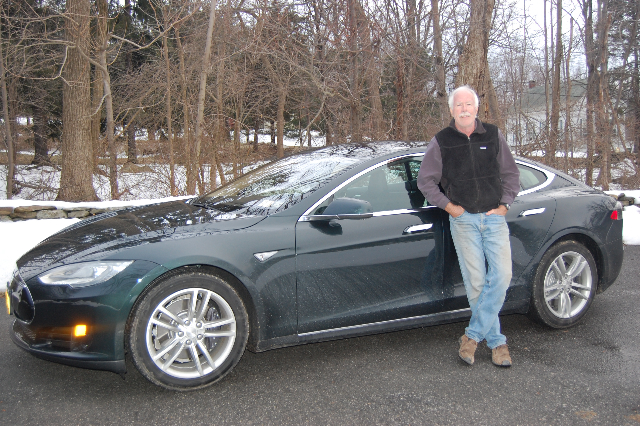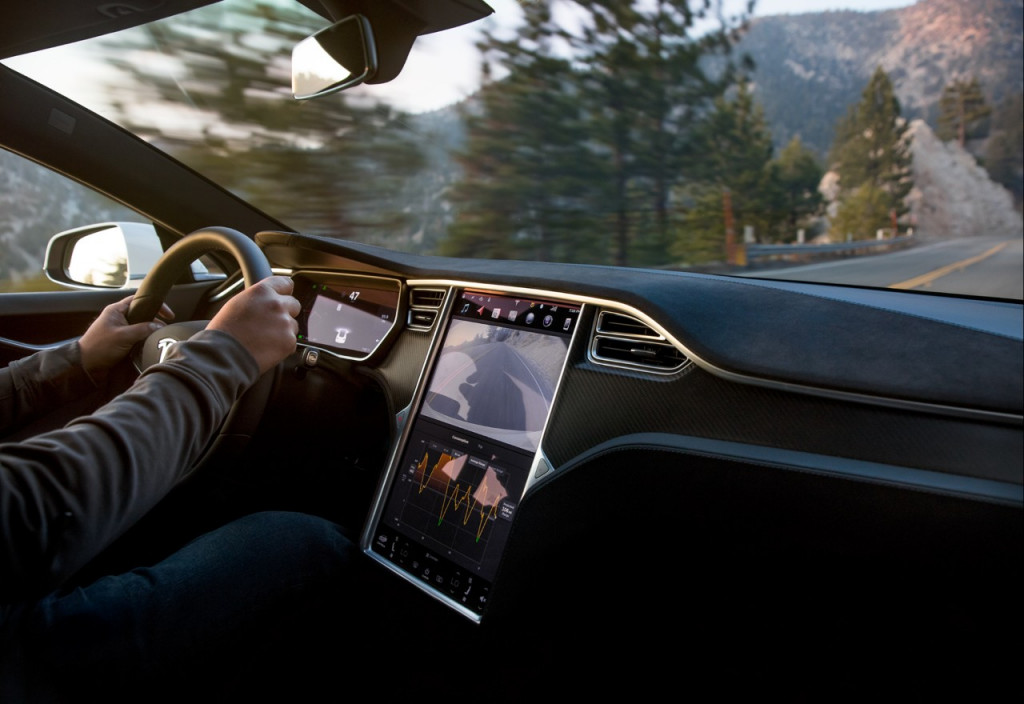When I bought my first Tesla Model S back in 2013, it had already been named that year’s Green Car Reports’ Best Car to Buy, and Consumer Reports had just declared it the best-scoring car they’d ever tested, noting that it broke their rating scale.
The Model S was an extraordinary car, and—at about the same sticker price as comparable ICE luxury cars like the Audi A7—a great value for the money.
On Tuesday, Tesla slashed prices for the Model S by $3,000, ramping up the value, and leading us to assess: In terms of bang-for-the-buck, how does this current Long Range version stack up against my “golden oldie” original Model S?

2013 Tesla Model S electric sport sedan on delivery day, with owner David Noland
It’s basically the same car, with no major platform or body changes since its introduction in 2012. Most car models get major redesigns every 4-6 years, but Tesla has let its flagship sail on for seven years now, with no hint of a redesign coming any time soon. In the interim, Porsche, Audi, BMW, Mercedes and others have all announced new state-of-the-art (their art, at least) electric luxury cars aimed squarely at Tesla.
Is the venerable Model S finally starting to approach obsolescence?
A quick look at the current car’s numbers and features on the Tesla website configurator provides a clear answer: No freakin’ way. The current Model S Long Range is a dramatically better car than the 2012 best-car-ever-tested S85, and a far better value for the money.
Let us count the ways:
40 percent longer range. My old 85-kwh Model S had an EPA range of 265 miles. The new one, with a bigger battery and more efficient drivetrain, is rated at a stunning 370 miles.
I always found the 265-mile number to be mostly good enough. Occasionally on long trips, though, if the temperature dipped below 30, or if a headwind kicked up, I wished for a bit more. (And I got it when I upgraded to a 2017 Model S 100D, EPA rated at 330 miles.)
But 370 miles is just crazy. It’s almost too much range—the point at which the extra miles might not be worth the extra cost and weight of the required battery capacity. The current Model S Long Range, combined with the Supercharger V3 network that’s on the way, puts a final, emphatic stake through the heart of "Range Anxiety."
![2013 Tesla Model S in Florida, during New York to Florida road trip [photo: David Noland] 2013 Tesla Model S in Florida, during New York to Florida road trip [photo: David Noland]](https://images.hgmsites.net/lrg/2013-tesla-model-s-in-florida-during-new-york-to-florida-road-trip-photo-david-noland_100454580_l.jpg)
2013 Tesla Model S in Florida, during New York to Florida road trip [photo: David Noland]
27 percent more efficient. The old 85 used 38 kwh of out-of-the-wall electricity to drive 100 miles, according to the EPA. Thanks to more efficient motors, inverters, and chargers, the current car uses just 30 kwh. And in terms of equivalent miles per gallon, the EPA lists 93 MPGe for the old 85, and 111 MPGe for the new Long Range.
41 percent quicker to 60 mph. The old 85 had a 0-60 time of 5.2 seconds, which made me and my passenger buddies giddy. Its smooth, instantaneous acceleration became Tesla’s hallmark, the thing that truly set it apart from all other cars. Yet the current Model S Long Range blows the old 85 away, with a 0-60 time of just 3.7 seconds—faster than the P85 Performance version of the original car.
Autopilot. The original car had no Autopilot, of course, and cannot be upgraded. The current car has as standard equipment a basic version of Autopilot, which enables the car to steer, accelerate and brake automatically for other vehicles and pedestrians within its lane.
Full self-driving. Tesla has already enabled lane-changing, off-ramps, auto-parking, and a “summon” feature for those who’ve chosen its future-leaning Full Self-Driving option, not available on the earlier Model S. More capabilities are expected for the FSD system later this year, and beyond.
![2013 Tesla Model S in winter, Hudson Valley, NY [photo: David Noland] 2013 Tesla Model S in winter, Hudson Valley, NY [photo: David Noland]](https://images.hgmsites.net/lrg/2013-tesla-model-s-in-winter-hudson-valley-ny-photo-david-noland_100454455_l.jpg)
2013 Tesla Model S in winter, Hudson Valley, NY [photo: David Noland]
All-wheel drive. My old 85 had rear-wheel drive, and I found that winter traction was mediocre with all-season tires. A couple of times I had problems getting out of my long snow-covered upstate New York driveway. The current Model S Long Range’s AWD system is vastly superior. My 100D, which has basically the same system, has always handled my driveway—and every other winter situation I’ve encountered—with aplomb.
Convenience items. My original car was a surprisingly spartan affair when compared to other luxury sedans in its price range. The current Long Range has mostly taken care of that inadequacy. It now includes full turn-by-turn navigation, expanded keyless entry with walk-away locking, a center console, parking sensors, LED headlamps, a panoramic glass roof, and better (heated) seats.
Bang for the buck. Astonishingly, in constant dollars, the current car, for all its advantages, actually costs less than the old one.
My 2013 car, with a 85-kwh battery, green metallic paint, leather seats, and air suspension, listed for $82,320 back in the day. Adjusted for inflation, that’s $90,836 in today’s dollars.

2019 Tesla Model S
A new Model S Long Range, with all the aforementioned standard features and the metallic paint option, today lists at $86,500 (not including the mandatory $1,200 destination and documents fee).
Standard Range comparison
Even Tesla’s current entry-level Model S, the Standard Range car, easily beats the old 85—for $14,000 less in today’s money.
Range is 20 miles better, at 285 miles. Acceleration to 60 mph, at 4.0 seconds, is more than a second quicker. Although the EPA has yet to publish an efficiency number, I would expect it to also be about 27 percent better than the old 85. And it has all the other advantages—basic Autopilot, AWD, and about as many convenience features as the Model S Long Range.
With the metallic paint option, it costs $76,500. That’s nearly $5,000 cheaper than the 2013 sticker price of the old 85. In inflation-adjusted dollars, it’s an 18-percent price reduction.
Simply put, the Model S keeps getting better and cheaper. At this rate, will we be able to buy a 2026 version with Level 5 automated driving, a 518-mile range, 2.6-second base 0-60 time, and a 132 MPGe efficiency rating—all for $82,400 in today’s dollars?
I can hardly wait.












